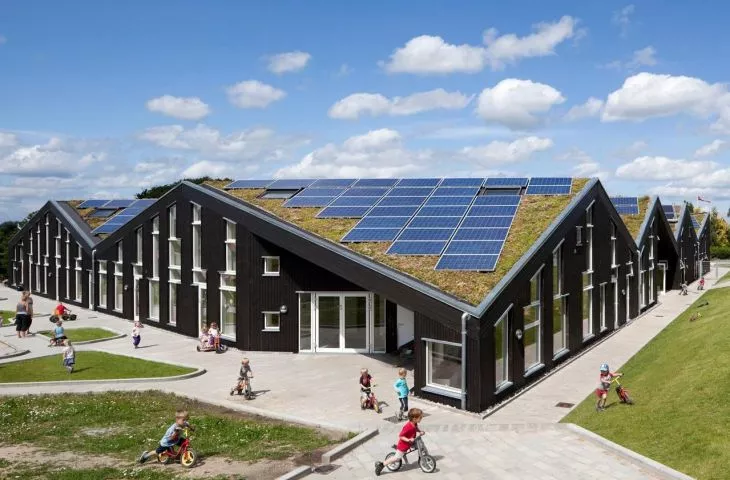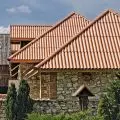The challenge for today's construction industry, both private and public, is sustainable design and the use of energy-efficient solutions that are both healthy for people and environmentally friendly. An example of a facility that combines all these elements is the Solhuset kindergarten in Hørsholm, Denmark, by Christensen & Co. architects, built in accordance with the Active Homes concept.
The facility, built in 2011 in Denmark, can still serve as a model for investments currently under construction in Poland. According to technical conditions, new buildings must be even more energy efficient and comply with the introduced EU regulations. The aim of the new regulations is to reduce the amount of energy required to cover the heat demand of buildings in all EU member states. This also applies to public buildings.
The building has a compact body with a dark façade with lots of windows
photo: Adam Mørk © Christensen & Co. architects
However, not only energy efficiency is important, the Active House concept developed by an international association - the Active House Alliance- is proof of this. Originating in Denmark and the Netherlands, the Active House concept stands for a residential building that combines energy efficiency, a high quality indoor climate and daylighting, and care for the environment.
Kindergarten on a triangular plan
The Solhuset kind ergarten building in Hørsholm, 30 km north of Copenhagen, was built according to its principles. Christensen & Co. archite cts created an integrated preschool care center with an area of 1,300 square meters for about 100 children and 30 staff members. Due to its geometry, window location and a range of cutting-edge green technologies at the time of construction, it was the world's first kindergarten to generate energy.
The kindergarten was designed on a triangular plan
© Christensen & Co. architects
The building has a compact body, designed in a triangular plan, with the two longest elevations facing southeast and southwest. Windows along these elevations, combined with skylights, let in more than three times more light than in a standard building, ensuring a healthy indoor climate at all times - summer and winter. All rooms have access to sunlight from at least two sides. In each, the architects designed high-hung ceilings and strategically placed windows to ensure optimal use of natural light. In addition, the placement of windows at different heights in the sloping roof facilitates quick and efficient ventilation of the rooms.
placement at different heights of windows in the sloping roof facilitates quick and efficient ventilation of the halls
photo: Adam Mørk © Christensen & Co. architects
An interesting feature is a weather station installed on the roof that works with carbon dioxide and temperature sensors in each room. It is a guarantor of a good climate - it protects against overheating, supplies fresh air, turns lights on and off according to needs and weather conditions, and saves energy. Natural ventilation is supported by mechanical ventilation and an automatic sunshade system that protects against overheating.
energy-generating building
The kindergarten uses renewable energy sources and, moreover, produces energy itself. Thanks to proper window placement and passive use of solar energy, half of the building's heating needs are met in winter. The other half is produced by an integrated solar and geothermal heating system. Solar collectors located on the southern slope of the roof, convert the sun's energy into heat and hot water, while 250 square meters of photovoltaic cells produce electricity. Solhuset was made to produce as much as 78 kWh/m² per year, which is 9 kWh/m² more than the projected electricity consumption.
The kindergarten uses renewable energy sources and produces energy itself
© Christensen & Co. architects
environmental protection
The outdoor area of the kindergarten is designed to represent the landscape of Denmark, including forested areas and a sandy zone, symbolizing the coast. The space is designed to support the preschoolers' environmental education. An interesting addition is the greenhouses, where children under the supervision of teachers can grow plants. It's worth mentioning that the architects used advanced software throughout the design process, and virtual tests resulted in subsequent improvements in energy efficiency, indoor air quality and daylight levels.
TheDanish kindergarten is a vision of construction that can respond to today's environmental challenges and user expectations - about 90 percent of our time is spent in buildings! Sustainable construction, in which an adequate indoor climate plays an important role, is also backed by health benefits. Natural light and fresh air promote learning, improve concentration, increase productivity, as well as help fight infections or reduce the risk of diseases such as asthma, allergies and depression.
For more information and design tips, visit VELUX ARCHITIPS.














































